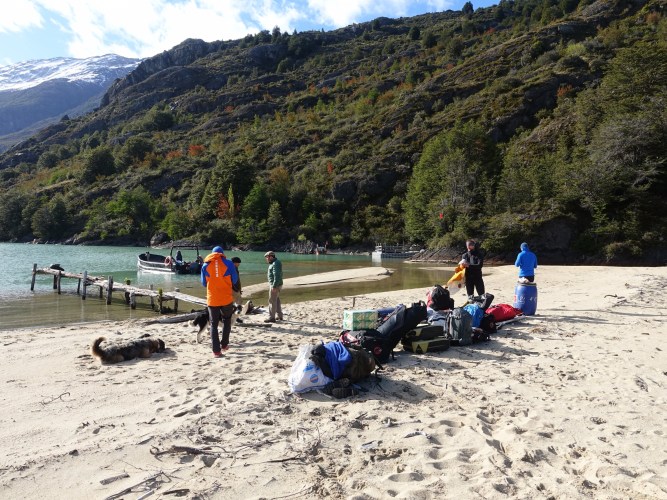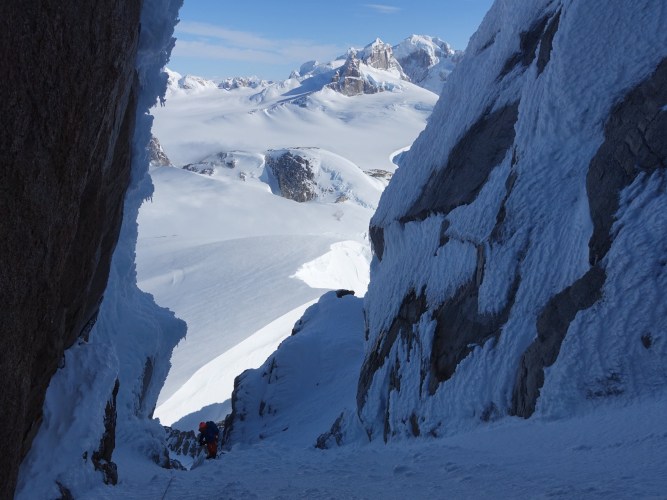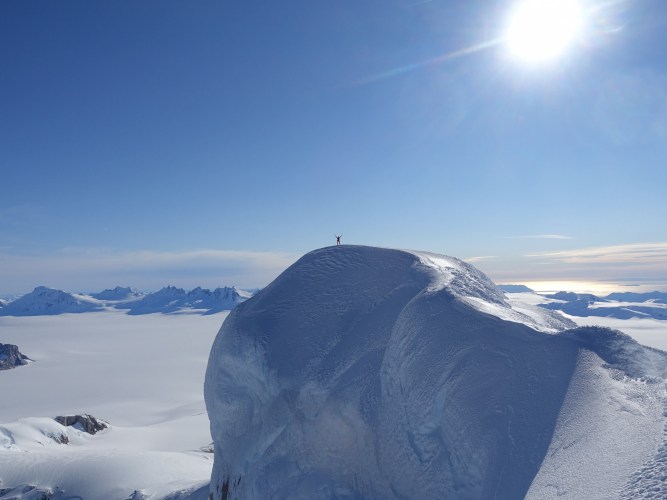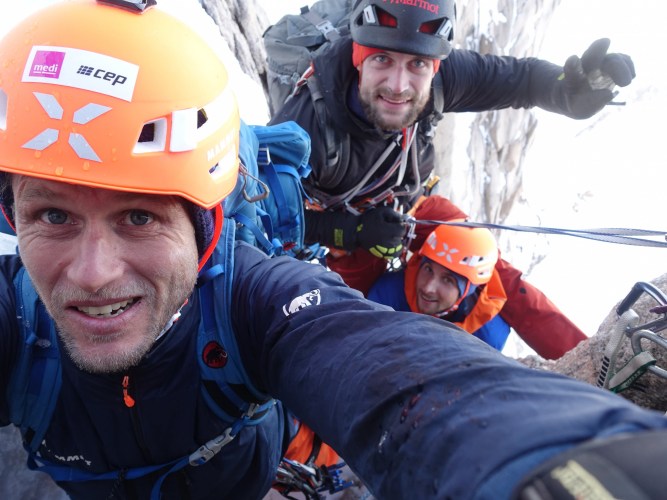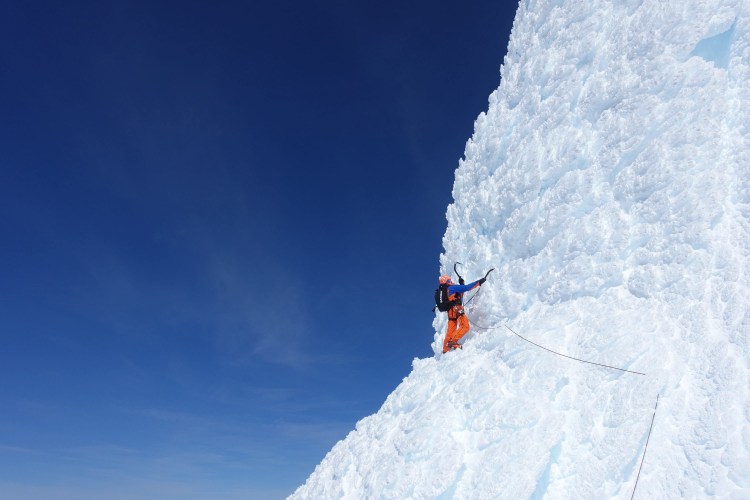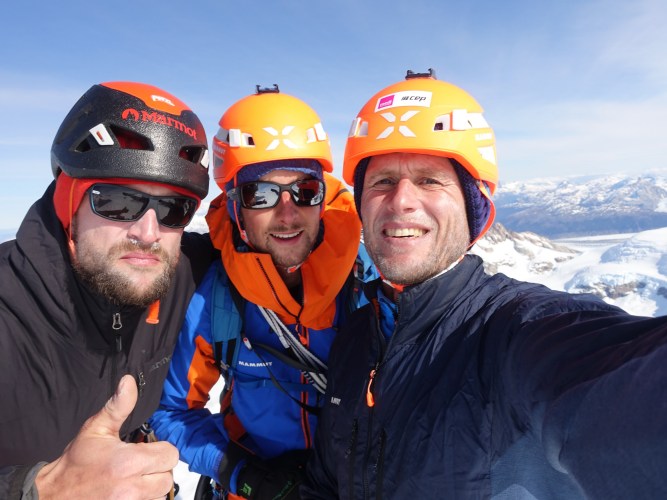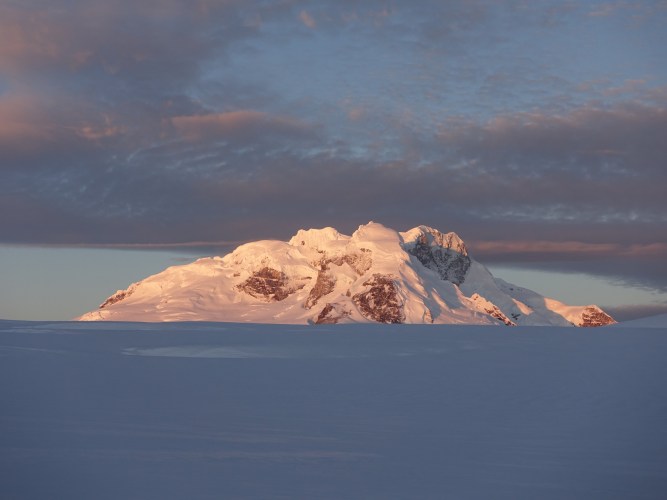Stephan Siegrist
Professional Alpinist
Cerro Cachet: Homage to Lost Friends
This is my 19th expedition to Patagonia but my first to the northern inland ice. Nicolas Hojac, Lukas Hinterberger, and I are awarded with a grand new route on the 2600-meter-high Cerro Cachet.

Text von Tobias Hatje ⸺ It‘s 6.20am as Lukas, Nico and I start making our way from our ABC at the foot of Cerro Cachet. A storm was raging outside just two hours ago. We slightly sink into the wet snow that fell the day before and find a good path through the crevices right away. Tons of ice keep breaking off, rushing to the depths beside us.The cracking and booming sounds of the seracs was already our everyday ambient noise that we heard all the way to our basecamp about 20km away.
At this point the idea and specific plans for this trip to Patagonia lie eleven months in the past. And the expedition was ill-fated at the beginning. I had been to Kashmir with Thomas Huber and Julian Zanker the year before and we were successful on Cerro Kishtwar back then. After bagging the summit, Julian and I immediately knew that we had to go on another expedition together again soon. So we did research on different areas around the globe. Then, on February 24th last year, the whole world suddenly changed: Julian had a fatal accident on the north face of the Eiger, a wall that he had climbed through so many times. I was in a shock-induced paralysis and lacking the motivation to continue planning the Patagonia project. Not even six weeks later the next shock: David Lama, a very good friend and expedition partner, was buried under an avalanche in Canada together with Hansjörg Auer and Jess Roskelley. It felt like the ground was being pulled away from under my feet. My passion for the mountains took a sabbatical, the thoughts in my mind were constantly spinning around in circles. I’m well aware that mountaineering always bears a residual risk. But the past impacts were so many and so close together in my tight-knit circle of friends. Should I really take on the not so insignificant, real dangers of an expedition again? Is it really worth it or am I just challenging my fate too much under these circumstances? Your perspective on the risks that you take changes with a family and children. On the other hand, I am quite aware that these expeditions, departing to seek the unknown, account for a significant part of my personality. I pulled myself together again after some time and together with Nico, who had jumped on board, we decided to continue to pursue the project “Northern Patagonia.” We were able to win over Lukas Hinterberger, an alpinist from Appenzell in Switzerland, with whom Nico had already been on expeditions to Pakistan and China. In addition, I asked Tobias Hatje from Hamburg, a friend and former companion on a past Kashmir expedition, to join us to basecamp.
Gallery
We arrived in Santiago de Chile exactly one month ago and spent more than three weeks in basecamp. Ten days ago we were able to summit Cerro Largo during a short window of good weather. The ascent to the 2799m high ice mushroom adorning the peak was more like a demanding ski mountaineering tour with a short ice climbing passage at the very end. A good introduction for our expedition but not the challenge we were actually looking for.
Now the first steeper climbing passages of Cachet finally lay before us. Everything is considerably larger and more impressive than we had realized looking through our binoculars.
A tremendous canyon marks the beginning. The walls are packed with rime ice on the sides that shines bright in the morning light. A magic sight that gives us a huge boost in motivation after so many rainy days spent in basecamp and our ABC-tent. But joy and frustration are always at close quarters with new routes: There’s euphoria on one hand when you find a good, fast way to the top right away. Then on the other hand there’s the pressure of time ticking to try out several variants because the remaining route is hard to see and assess. You never know exactly how things will continue and tension mounts with every ledge, just like in a good thriller.
I rappel 20 meters on the Col into the east side to maybe discover a way to the pass there. A loud booming sound roars over to where we are and we realize that the danger of avalanches is much bigger on the lee side. We finally make it to the pass at 10am at 2054 meters in altitude. The first 1500 meters in altitude gain lie behind us, a 600-meter-high, vertical wall rises into the blue Patagonian sky before us. Uncharted climbing territory. One of the rare white spots in the vertical world that mean about as much to us alpinists as the big nuggets did in the Yukon during the time of the gold diggers of the 19th century. Up until now the Cerro Cachet had only been climbed twice via the fairly easy terrain on the side facing the inland ice.
We leave the first 80 climbing meters behind us fast, even if the thin sheet of ice on the rock slabs keeps melting like butter in the microwave. We’re already being hit by bits and pieces of ice, a sign that we have to move swiftly. Things get hectic. Our gear is still in our backpacks and not hanging from our harnesses in a sorted manner. Valuable time is lost until I can begin climbing. The thin snow cover breaks like cookies in a bench vise under my crampons. I have to clear the rock from the snow first to detect the smallest crimps in the granite where my ice axes find hold. Placing a piece of protection is almost unthinkable. It feels pretty unsexy because I’m about ten meters above and diagonal to my partners Lukas and Nico. And a pendulum fall in a situation like this isn’t exactly what you need. Rappelling an injured person from a wall like this takes hours. After that a descent over several hours via the glacier and pass back to basecamp would follow. And even in basecamp you’d be in the middle of nowhere. A transport of a few days would then bring you back to Puerto Bertrand, the first stop back in civilization. You won’t find any medical care there yet either. A rescue with a military helicopter would maybe be an option but very unrealistic with the current weather conditions. With other words: an accident in our situation would be the worst-case scenario.
Having this thought in the back of your head doesn’t make it easier to find a route in a wall that involves serious climbing. Our entire experience as alpinists is on demand and Nico and Lukas have quite a bit to show for it. Both of them were in the elite expedition squad of the Swiss Alpine Club SAC. Nico was just 18 years old when he climbed the north face of the Eiger for the first time. He holds the team speed record on the Eiger with 3 hours 46 minutes together with Ueli Steck. He is also the cameraman and photographer for our expedition. Just like Nico it’s also Lukas’, whose nickname is Hönti, first trip to Patagonia. The alpinist from Appenzell is currently working on increasing his wealth of experience as a certified mountain guide aspirant. And he’s built like a brick house: he takes his well-toned muscles out to play every day at the climbing board at basecamp. His guns are a real help but not enough to find an optimal route. We’re below a big wall that you could conquer by strenuously climbing though a crack. But that would be very time consuming. And there’s one thing you basically never have on the mountain in Patagonia: time. In our case it’s a mere day because the weather forecast shows wind speeds of about 100 kilometers per hour the next morning already.
We choose another route than the crack, Nico takes over the lead. He champions the “boulder”, a short steep ridge you can’t use protection on. After that the rope runs up quickly signaling Hönti and me that it gets a little easier after that. We finally hear „off belay“ from Nico and we follow him. The next 60 meters of the ice ramp are under-run by water. “Damn fucking ice!” we hear booming from above. Nico is fighting with the conditions but he’s ultimately successful in placing the next belay anchor on a split-off rock pillar. We follow his lead again, the ragged Nef Glacier below us is well visible. We continue through a chimney; Lukas takes over the lead. Crampons crunch on rock, the mobile protection on our harnesses scratches at the granite, he makes his way forward centimeter by centimeter. He can barely move in the extremely tight chimney, his hip gets jammed between the rock, he’s cursing and fighting. As he looks down to us his wide-open eyes reveal that he’s really being challenged at the moment. We finally hear the liberating “off belay” after some time. Another pitch is established. It’s the hardest in our route as we later discover. We finally stand on the ridge to the summit after another 120 meters of easy climbing. We untie from the rope and swiftly make our way across light rime ice and snow to the main peak.
We did it. We lie in each other’s arms, exhausted, round about 12 hours after leaving ABC. The wall was really demanding but our tactic and choice of route proved to be right on. We leave a tiny doll at the summit after taking our photos. It’s a tribute to Julian. This way he was with us during our first ascent and climbed to the peak with us. We call our route Homenaje a los amigos perdidos (Homage to Lost Friends) for Julian, but also For David Lama and Ueli Steck.
Gallery
The descent is still waiting for us and it’s already 7pm. We decide to rappel in a direct line and we make good progress, even though falling rime ice does cause a few critical moments at the end. But we remain unscathed and reach ABC in the light of our headlamps shortly after midnight by the skin of our teeth. The following day we make our way back to our ‘jungle’ basecamp that lies protected in a small forest. After all this time it became somewhat of a home in the Patagonian wilderness. And we are happy to have put in so much effort in building the camp. It radiates a certain kind of coziness and safety. We relax the next days, recover from the strains of the summit ascent and enjoy our last, saved “liquid chicken” – the last beer.
We have ten days left, enough time for a small peak above our camp. It’s a bizarre moon landscape that presents itself 1500 meters in altitude above our basecamp. With little towers, disks, huge humps milled from the granite rock – a scenario like from the movie “Lord of the Rings”, with only Gandalf missing.
The two gauchos Hector and Andaluis show up in basecamp with the packhorses like we arranged. Our ‘Swiss Exped 2019’ is coming to an end. It was my 19th expedition to Patagonia in total, but my first to the edge of the northern inland ice. It was also a déjà vu: memories of the first expeditions that had their starting point in El Chaltén, today’s Mecca of the climbing scene, came alive. The place was just a few houses back in the 90ies, you had to organize everything yourself and the basecamps of the different expeditions were the places to go during bad weather. It was pure, exposed, wild and isolated back then – just like I felt it again during our ‘Northern Patagonia Expedition’. It’s exactly that which fuels my passion for expeditions. Into the Wild – like Julian, David and Ueli liked it best too.

